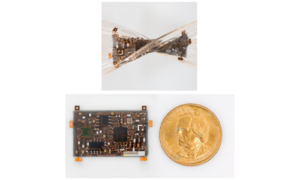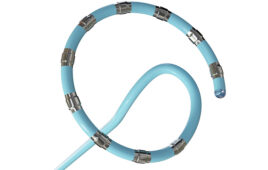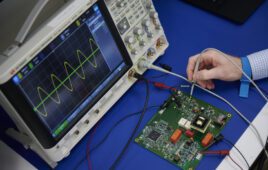
[Image from UC San Diego]
The researchers stacked and connected laters of stretchable circuits on top of other circuits to build the electronic patch that keeps its functions while staying thin and small in size. The patch can be worn on the skin like a bandage to wirelessly monitor different physical and electrical signals like respiration, body motion, temperature, eye movement and heart and brain activity. The researchers suggest that the device could also be used to control a robotic arm wirelessly.
“Our vision is to make 3D stretchable electronics that are as multifunctional and high-performing as today’s rigid electronics,” senior author and UCSD nanoengineering professor Sheng Xu said in a press release.
As small and thick as a U.S. dollar coin, the researchers built the stretchable electronics upwards instead of outwards.
“Rigid electronics can offer a lot of functionality on a small footprint–they can easily be manufactured with as many as 50 layers of circuits that are all intricately connected, with a lot of chips and components packed densely inside. Our goal is to achieve that with stretchable electronics,” Xu said.
The device has four layers of interconnected stretchable, flexible circuit boards. Each of the layers are built on a silicone elastomer substrate that is patterned with an island-bridge design. The islands are small, rigid electronic parts such as a sensor, antenna, Bluetooth chip, amplifier, accelerometer, resistor, capacitor or inductor. The electronic part is then attached to an elastomer and the islands are connected by stretchy bridges that are made from thin, spring-shaped copper wires. The bridges allow the circuits to stretch, bend and twist without the electronic parts losing their functions.
“The problem isn’t stacking the layers. It’s creating electrical connections between them so they can communicate with each other,” Xu said.
Vertical interconnect accesses (VIAs) help make the electrical connections. VIAs are small conductive holes that can go through the different layers of a circuit. Traditionally they are made using lithography and etching, which usually works well with rigid electronic substrates, but they don’t work with stretchable elastomers.
Instead of using lithography, the researchers decided to use lasers. They mixed silicone elastomer with black organic dye so the elastomer could absorb energy from the laser beam. The circuits were then stacked onto each elastomer layer and were exposed with a laser beam to create VIAs. Once they were exposed to the laser beams, the researchers filled the VIAs with conductive materials so that the layers could be electrically connected.
The research team built a 3D stretchable electronic device that they called a smart bandage. They applied it to different parts of the body to wirelessly monitor electrical signals. When it was worn on the chest of stomach, it could record heart signals like an electrocardiogram. When placed on the forehead, it could record brain signals like an EEG sensor. It recorded eyeball movements from being placed on the side of the head and it recorded muscle activity and could control a robotic arm when used on the forearm. The smart bandage they developed could also monitor respiration, skin temperature and body motion.
“We didn’t have a specific end use for all these functions combined together, but the point is that we can integrate all these different sensing capabilities on the same small bandage,” Zhenlong Huang, one of the researchers on the project, said.
The device is made using high-quality parts and the bandage can last former than six months without losing performance, stretchability and flexibility. It can also communicate wirelessly with a smartphone or laptop that is up to 10 meters away. The entire device uses about 35.6 milliwatts of power.
“This device is like a ‘master of all trade.’ We picked high quality, robust subcomponents–the best strain sensor we could find on the market, the most sensitive accelerometer, the most reliable ECG sensor, high quality Bluetooth, etc.–and developed a clever way to integrate all these into one stretchable device,” Yang Li, one of the authors on the study, said.
The research team is now working on optimizing and refining the technology. They hole to test the smart bandage and electronics in a clinical setting in the future.
The research was published in the journal Nature Electronics and was funded by the Center for Wearable Sensors, Center of Healthy Aging and the Contextual Robotics Institute at UCSD.




